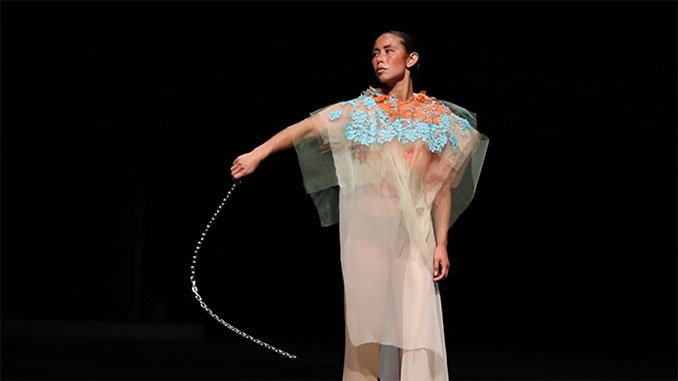 The dance world has just re-emerged from “a massive dark period”, says Deborah Brown, former choreographer for Bangarra Dance, who is now part of a wave of female choreographers of diverse heritage going solo.
The dance world has just re-emerged from “a massive dark period”, says Deborah Brown, former choreographer for Bangarra Dance, who is now part of a wave of female choreographers of diverse heritage going solo.
These artists are curating heart-driven, personal narrative forward work as theatres and studios reopen their doors following the reckoning of the past three years.
Brown believes the works have become more urgent through the crisis: “As dancers we are very instinctual… we rely on breath, closeness… something Covid threatened. I felt guarded and reserved, we all had to step back.”
Brown’s choreography, The Wave, was recently shown at Arts Centre Melbourne as part of Alice Topp’s vision, Project Animo, a consortium of forward-thinking dance artists and choreographers. Topp, former dancer with and choreographer for Australian Ballet, hopes through the project to:
“…deconstruct the idea of what it means to be in your “prime” in the dance industry… to flip the script on normal company models… and nurture voices from all walks of life.” Choreographers and dance artists of diverse backgrounds and ages, are coming up for air in a post-pandemic climate of possibility.
Brown’s The Wave was a solo performance, featuring former Australian Ballet dancer Madeleine Eastoe. The piece had Eastoe dancing through sea-like fabric, doused in dappled light, expressing the ebb and flow of the sea and life itself.
“I like exploring the depths of the ocean,” Brown adds, “an underwater night’s sky… I often dream of being underwater.” She goes on to detail how her Torres Strait heritage is deeply connected with the coast, as her ancestors dove into the deep for shells and seafood. Such works are mould-breaking.
As Brown points out, they explore realities and narratives of diverse female artists through their own voices and bodies, in contrast to traditional ballets which have master narratives of fairy-tale female characters who struggle against a preordained fate.
The new wave of female choreographers “want to be really seen, to share what [they] care deeply about, for [their] movement to hold power,” says Lilian Steiner, Melbourne raised choreographer. She is currently developing Siren Dance, set to premiere at Dancehouse later this month.
Siren Dance is a piece that Lilian began creating in early 2019, pre-pandemic, after invitations from Dance festivals in Europe. It is a solo contemporary dance piece that speaks to her continuous endeavour to capture and hold her audience’s attention, as she shifts through different versions or reveals aspects of herself throughout her career.
In Siren Dance, classical and contemporary references rub up against each other in aesthetics and movement language, including an exciting, revitalised use of pointe shoes.
She says: “in some ways, this work describes the way audiences often fetishize particular aspects of dance and often misunderstand what I believe is really beautiful about, and the essence of, Dance.”
Steiner, like former Australian Ballet dancer Juliet Burnett, has had the chance to deepen her connection with home after the consolidation and challenges of the last two years with COVID.
Burnett is moving back from her prestigious role as first soloist at Opera Ballet Vlaanderen in Belgium to focus on her choreography and artistic direction back home in Australia.
“The past few years have highlighted how retrograde we actually are… in the Australian dance industry… it took a mode of introspection via the pandemic to look at how we can do better,” Burnett says, as she prepares to launch her own Multi-Arts company on her return to Australia this year, A_PART.
She relates to her experiences dancing internationally as further highlighting the need for change here. Burnett, like Steiner, was part of Think Tank Dance Assembly funded by Ausdance Vic, which met online during the lengthy Melbourne lockdown to facilitate “conversations about several important issues… thrown into sharp relief by the pandemic.”
These artists are dancing and talking into the new era, unafraid to be heard, after a period where live theatre was lost at sea. Performance venues are now becoming awash with diverse bodies and perspectives as adventurous dance artists are starting to realise, as Burnett articulates, “what we’re all missing out on, if we don’t allow for broader representation in dance.”
The dance industry with its patterns of exclusion, predominantly of both women and diverse choreographers, is to the detriment of creativity and relevancy of the art form to fresh audiences. As Topp states with a hopeful glow, there is a sea-change happening in the dance world in Australia and “we are at a turning point in many ways.”
These words, however coincidental, were the also the title of the damning report made in 2018, Turning Pointe, undergone at National Institute of Dramatic Arts by Andrew Westle. The report exposed a dearth of representation for female choreographers.
There remains to be another study of this scope undertaken in the post-pandemic era but the signs are vital. It’s high tide for diverse female choreographers and they are starting to be seen and heard across the dance scene at last.
Lilian Steiner’s Siren Dance will be presented at the Sylvia Staehli Theatre – Dancehouse: 24 – 27 March 2022. For more information, visit: www.dancehouse.com.au for details.
Image: Lilian Steiner at Deltebre Dansa, Spain – photo by Albert Vidal | Vèrtex Comunicació
Author: Leila Lois
